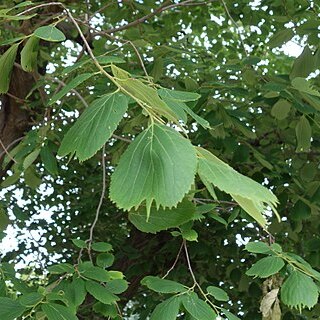Trees, to 15 m tall, deciduous. Bark gray. Branchlets brown, glabrous or with a few hairs near nodes, with scattered small elliptic lenticels. Winter buds brown, 2-4 mm; inner scales brown pubescent. Petiole brown, 0.5-1.5 cm, adaxially with a narrow and sharply defined furrow, glabrous or sparsely pubescent; leaf blade elliptic, obovate-elliptic, or rarely broadly obovate, 7-12 × 3.5-10 cm, papery, glabrous or abaxially sparsely pubescent but sometimes only on veins and vein axils, base broadly cuneate, ± rounded, or ± cordate and slightly oblique, margin deeply laciniate-toothed, teeth 15-24 on each side and 4-8 mm, apex truncate with a caudate tip; secondary veins 3 or 4 on each side of midvein. Flowers solitary or fascicled. Style branches linear, undivided. Infructescence stout, solitary, glabrous or sparsely pubescent, 1.5-2.5 cm, 2-2.5 × as long as subtending petiole. Drupe 1 per infructescence, orangish yellow, dark brown when mature, ± globose to ellipsoid, 1-1.3 cm, basally and apically obtuse. Stone grayish brown, ovoid-elliptic, ca. 8 mm in diam., reticulately foveolate, 4-ribbed. Fl. Apr-May, fr. Sep-Oct.
More
A tree. It grows 15 m tall. The bark is grey. The leaves are oval and 7-12 cm long by 4-10 cm wide. They are papery. The flowers can occur singly or in groups. The fruit is fleshy and yellow to orange but becoming dark brown when ripe. They are oval or round and 1.3 cm across. It has a stone that is wrinkled and ribbed.


